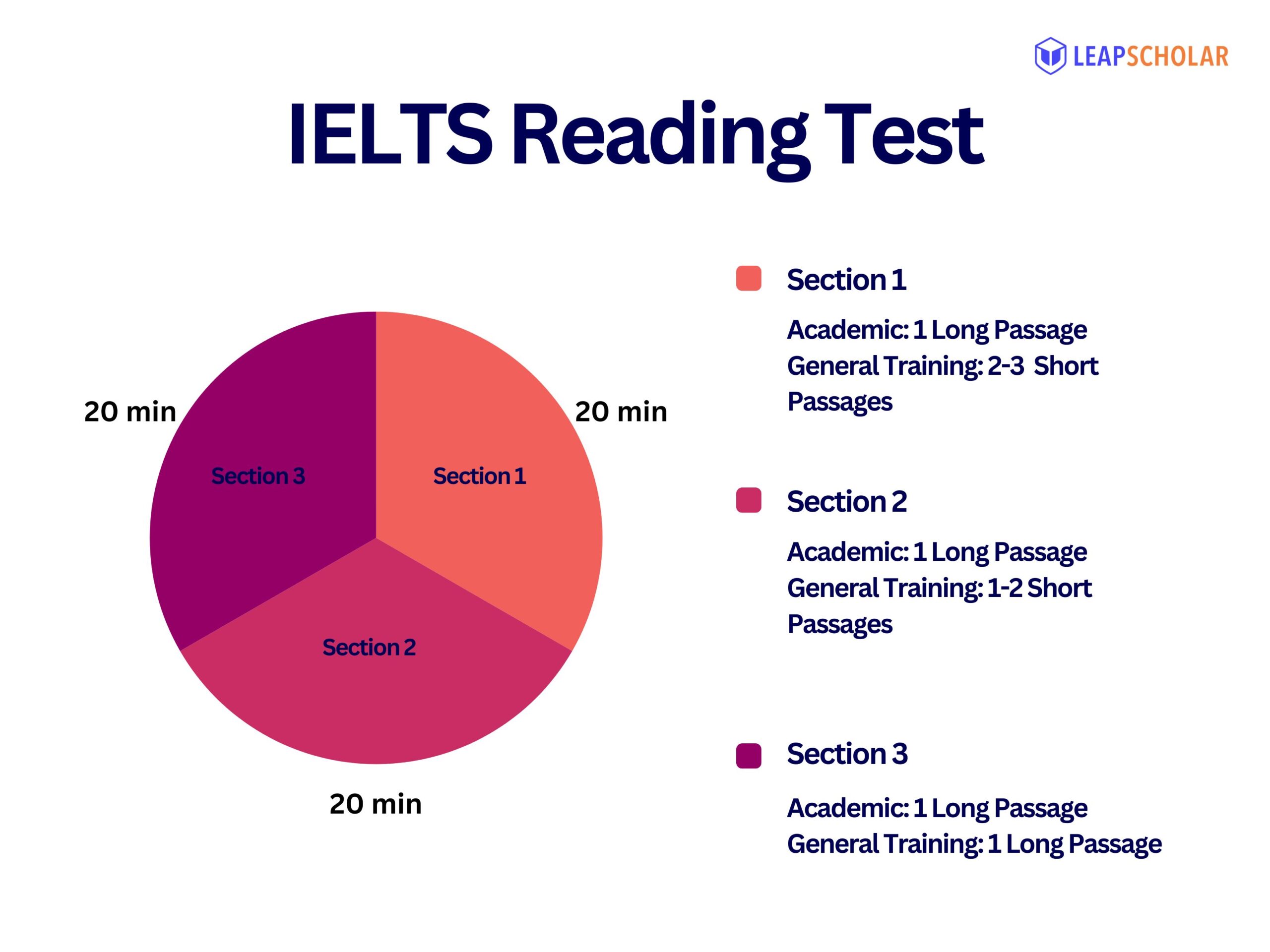All set for IELTS, but stuck with the IELTS Reading test? Then try solving the Step Pyramid of Djoser Reading Passage.
The IELTS Reading is one of the four modules of the IELTS test. The Reading module consists of three or more passages, followed by 40 questions. The details of the Reading module are mentioned below.
Check out the details of the IELTS Reading Test:
| Duration | 60 minutes |
| Number of Questions | 40 |
| Number of Sections | 3 |
| Number of Passages | Academic: 3 General Training: 4- 6 |
| Band Score | 1-9 |
| Question Types | – Multiple Choice Questions – Matching Information – Matching Headings – Matching Features – Matching Sentence Endings – Sentence Completion – Summary, Notes, Tables, Flow-chart Completion – Diagram Label Completion – Identifying Information – Identifying a Writer’s Views/Claims – Short-answer Questions |
The IELTS Reading test consists of three sections. It is recommended to complete each section within 20 minutes.

Other sections of the IELTS exam are the Writing, Speaking and Listening. Try to practice sample question sets for all the modules.
The Step Pyramid Of Djoser Reading Passage explains the history of Egyptian pyramids and how the monument began during the reign of the great Egyptian king Dojser. Read the given passage carefully and try to answer the following questions.
The given passage comprises three question sets:
- Matching Headings
- Note Completion
- Multiple Choice questions
These are the 3 most commonly asked question types in the IELTS Reading test.
Check out the Step Pyramid of Djoser reading answers and explanations given. The references given for each answer will help you locate the answers within the passage.
Leap Advantage Virtual Spot Offer Event on May 10th 2024

Last call to secure your spot for Masters in US for Fall ’24 Intake
Leap Advantage Virtual Spot Offer Event on May 10th 2024
Last call to secure your spot for Masters in US for Fall ’24 Intake

The Step Pyramid of Djoser Reading Passage
Check out the Step Pyramid of Djoser reading passage below. Read the passage carefully and answer the following questions.
Paragraph 1: The pyramids are the most famous monuments of ancient Egypt and still hold enormous interest for people in the present day. These grand, impressive tributes to the memory of the Egyptian kings have become linked with the country even though other cultures, such as the Chinese and Mayan, also built pyramids. The evolution of the pyramid form has been written and argued about for centuries. However, there is no question that, as far as Egypt is concerned, it began with one monument to one king designed by one brilliant architect: the Step Pyramid of Djoser at Saqqara.
Paragraph 2: Djoser was the first king of the Third Dynasty of Egypt and the first to build in stone. Prior to Djoser’s reign, tombs were rectangular monuments made of dried clay brick, which covered underground passages where the deceased person was buried. For reasons which remain unclear, Djoser’s main official, whose name was Imhotep, conceived of building a taller, more impressive tomb for his king by stacking stone slabs on top of one another, progressively making them smaller, to form the shape now known as the Step Pyramid. Djoser is thought to have reigned for 19 years, but some historians and scholars attribute a much longer time for his rule, owing to the number and size of the monuments he built.
Paragraph 3: The Step Pyramid has been thoroughly examined and investigated over the last century, and it is now known that the building process went through many different stages. Historian Marc Van de Mieroop comments on this, writing ‘Much experimentation was involved, which is especially clear in the construction of the pyramid in the centre of the complex. It had several plans … before it became the first Step Pyramid in history, piling six levels on top of one another …The weight of the enormous mass was a challenge for the builders, who placed the stones at an inward incline in order to prevent the monument breaking up.’
Paragraph 4: When finally completed, the Step Pyramid rose 62 meters high and was the tallest structure of its time. The complex in which it was built was the size of a city in ancient Egypt and included a temple, courtyards, shrines, and living quarters for the priests. It covered a region of 16 hectares and was surrounded by a wall 10.5 meters high. The wall had 13 false doors cut into it with only one true entrance cut into the southeast corner; the entire wall was then ringed by a trench 750 meters long and 40 meters wide. The false doors and the trench were incorporated into the complex to discourage unwanted visitors. If someone wished to enter, he or she would have needed to know in advance how to find the location of the true opening in the wall. Djoser was so proud of his accomplishment that he broke the tradition of having only his own name on the monument and had Imhotep’s name carved on it as well.
Paragraph 5: The burial chamber of the tomb, where the king’s body was laid to rest, was dug beneath the base of the pyramid, surrounded by a vast maze of long tunnels that had rooms off them to discourage robbers. One of the most mysterious discoveries found inside the pyramid was a large number of stone vessels. Over 40,000 of these vessels, of various forms and shapes, were discovered in storerooms off the pyramid’s underground passages. They are inscribed with the names of rulers from the First and Second Dynasties of Egypt and made from different kinds of stone. There is no agreement among scholars and archaeologists on why the vessels were placed in the tomb of Djoser or what they were supposed to represent. The archaeologist Jean-Philippe Lauer, who excavated most of the pyramid and complex, believes they were originally stored and then give a ‘proper burial’ by Djoser in his pyramid to honour his predecessors. There are other historians, however, who claim the vessels were dumped into the shafts as yet another attempt to prevent grave robbers from getting to the king’s burial chamber.
Paragraph 6: Unfortunately, all of the precautions and intricate design of the underground network did not prevent ancient robbers from finding a way in. Djoser’s grave goods, and even his body, were stolen at some point in the past and all archaeologists found were a small number of his valuables overlooked by the thieves. There was enough left throughout the pyramid and its complex, however, to astonish and amaze the archaeologists who excavated it.
Paragraph 7: Egyptologist Miroslav Verner writes, ‘Few monuments hold a place in human history as significant as that of the Step Pyramid in Saqqara … It can be said without exaggeration that this pyramid complex constitutes a milestone in the evolution of monumental stone architecture in Egypt and in the world as a whole.’ The Step Pyramid was a revolutionary advance in architecture and became the archetype which all the other great pyramid builders of Egypt would follow.
Also Read: IELTS Speaking Questions with Answers 2024
Questions for The Step Pyramid of Djoser Reading Passage
Crack IELTS Exam in first attempt

Attend Leap’s free masterclass to get tips, tricks and advance strategies to crack IELTS exam in first attempt
Crack IELTS Exam in first attempt
Attend Leap’s free masterclass to get tips, tricks and advance strategies to crack IELTS exam in first attempt

Questions 1-7
The Step of Pyramid Djoser Reading Passage has seven paragraphs, A-G.
Choose the correct heading for each paragraph from the list of headings below.
Write the correct number, i-ix, for questions 1-7 on your answer sheet.
List of Headings
i. The areas and artefacts within the pyramid itself
ii. A difficult task for those involved
iii. A king who saved his people
iv. A single certainty among other less definite facts
v. An overview of the external buildings and areas
vi. A pyramid design that others copied
vii. An idea for changing the design of burial structures
viii. An incredible experience despite the few remains
ix. The answers to some unexpected questions
1. Paragraph 1
2. Paragraph 2
3. Paragraph 3
4. Paragraph 4
5. Paragraph 5
6. Paragraph 6
7. Paragraph 7
Also Read: IELTS Listening Practice Test 2024
Questions 8-11
Complete the notes below.
Choose ONE WORD ONLY from the passage for each answer.
Write your answers for the questions 8-11 on your answer sheet.
The Step Pyramid of Djoser
The complex that includes the Step Pyramid and its surroundings is considered to be as big as an Egyptian 8 __________ of the past. The area outside the pyramid included accommodation that was occupied by 9 __________, along with many other buildings and features.
A wall ran around the outside of the complex, and a number of false entrances were built into this. In addition, a long 10 __________ encircled the wall. As a result, any visitors who had not been invited were cleverly prevented from entering the pyramid grounds unless they knew the 11 __________ of the real entrance.
Questions 12-13
Choose TWO letters, A-E.
Write the correct letters for questions 12 and 13 on your answer sheet.
Which TWO of the following points does the writer make about King Djoser?
A. Initially, he had to be persuaded to build in stone rather than clay.
B. There is disagreement concerning the length of his reign.
C. He failed to appreciate Imhotep’s part in the design of the Step Pyramid.
D. A few of his possessions were still in his tomb when archaeologists found it.
E. He criticised the design and construction of other pyramids in Egypt.
Also Read: IELTS Writing Task
The Step Pyramid Of Djoser Reading Answers with Explanations
1. Answer:
iv – A single certainty among other less definite facts
Reference:
From Paragraph 1: The evolution of the pyramid form has been written and argued about for centuries. However, there is no question that, as far as Egypt is concerned, it began with one monument to one king designed by one brilliant architect: the Step Pyramid of Djoser at Saqqara.
Explanation:
The given reading passage, The Step Pyramid Of Djoser, explains the evolution of the pyramids. According to the passage, the history of pyramids originated from the ancient king Djoser. Although there are numerous debates among historians and archaeologists regarding the structure of pyramids, the only thing they agree upon is the fact that the pyramids began with the reign of Djoser. Since the information is given in paragraph 1 matches with the title A single certainty, among other less definite facts.
2. Answer:
vii – An idea for changing the design of burial structures
Reference:
From paragraph 2: Prior to Djoser’s reign, tombs were rectangular monuments made of dried clay brick, which covered underground passages where the deceased person was buried. For reasons which remain unclear, Djoser’s main official, whose name was Imhotep, conceived of building a taller, more impressive tomb for his king by stacking stone slabs on top of one another, progressively making them smaller, to form the shape now known as the Step Pyramid.
Explanation:
The second paragraph explains the evolution of the tomb structures in ancient Egypt. According to the above-given lines, the earlier forms of the tombs were rectangular. They were also made out of clay. Imhotep, Djoser’s main architect, redesigned it using stones. He altered the previous shape of the tomb as well. So, the title An idea for changing the design of burial structures matches with paragraph 2.
3. Answer:
ii – A difficult task for those involved
Reference:
From paragraph 3: The weight of the enormous mass was a challenge for the builders, who placed the stones at an inward incline in order to prevent the monument breaking up.’
Explanation:
According to the passage, the builders of Djoser’s first pyramid faced difficulty managing the weight of the huge stone bricks. They tried to incline the shape inwards to prevent it from falling apart. Since paragraph 3 mentions the difficult task, the title A difficult task for those involved matches with it.
4. Answer:
v – An overview of the external buildings and areas
Reference:
From paragraph 4: The complex in which it was built was the size of a city in ancient Egypt and included a temple, courtyards, shrines, and living quarters for the priests. It covered a region of 16 hectares and was surrounded by a wall 10.5 meters high. The wall had 13 false doors cut into it with only one true entrance cut into the southeast corner; the entire wall was then ringed by a trench 750 meters long and 40 meters wide.
Explanation:
According to the passage, the pyramid was built in a huge complex, which made other buildings such as temples, courtyards, shrines and priests’ living quarters. Paragraph 4 also describes the area where the pyramid was built. The land encompassed an area of 16 hectares and was surrounded by a huge wall. So, the given paragraph accurately matches the title An Overview of the External Buildings and Areas.
5. Answer:
i – The areas and artefacts within the pyramid itself
Reference:
From Paragraph 5: The burial chamber of the tomb, where the king’s body was laid to rest, was dug beneath the base of the pyramid, surrounded by a vast maze of long tunnels that had rooms off them to discourage robbers. One of the most mysterious discoveries found inside the pyramid was a large number of stone vessels.
Explanation:
According to the above-mentioned lines, the area inside the pyramid consisted of numerous long tunnels to prevent the robbers. The tomb also had artefacts, including stone vessels. As per the information given, paragraph 5 matches the title, The areas and artefacts within the pyramid itself.
6. Answer:
viii – An incredible experience despite the few remains
Reference:
From paragraph 6: Djoser’s grave goods, and even his body, were stolen at some point in the past, and all archaeologists found were a small number of his valuables overlooked by the thieves. There was enough left throughout the pyramid and its complex, however, to astonish and amaze the archaeologists who excavated it.
Explanation:
According to the given paragraph, the thieves stole almost all of the expensive goods in front of the king’s tomb. However, some ancient pieces were still left within the pyramid and its complex. Excavating these was an incredible experience for the archaeologists. So, the title An incredible experience despite the few remains, matches paragraph 6.
7. Answer:
vi – A pyramid design that others copied
Reference:
From paragraph 7: The Step Pyramid was a revolutionary advance in architecture and became the archetype which all the other great pyramid builders of Egypt would follow.
Explanation:
The passage’s final paragraph explains the significance of the step pyramid in the history of monumental architecture. It also mentions that the step pyramid became a model for all the future pyramids made within the Egyptian civilisation.
8. Answer: City
Reference:
From paragraph 4: When finally completed, the Step Pyramid rose 62 meters high and was the tallest structure of its time. The complex in which it was built was the size of a city in ancient Egypt and included a temple, courtyards, shrines, and living quarters for the priests. It covered a region of 16 hectares and was surrounded by a wall 10.5 meters high.
Explanation:
According to the passage, the step pyramid was built within a huge complex. The area of the complex was 16 hectares. It includes other buildings as well. As per the information, the land was about the size of a city in ancient Egypt.
9. Answer: Priests
Reference:
From paragraph 4: When finally completed, the Step Pyramid rose 62 meters high and was the tallest structure of its time. The complex in which it was built was the size of a city in ancient Egypt and included a temple, courtyards, shrines, and living quarters for the priests. It covered a region of 16 hectares and was surrounded by a wall 10.5 meters high.
Explanation:
The area outside the step pyramid consisted of several other buildings, including a temple, courtyards and shrines. In addition, it also had the living quarters for priests.
10. Answer: Trench
Reference:
From paragraph 4: The wall had 13 false doors cut into it with only one true entrance cut into the southeast corner; the entire wall was then ringed by a trench 750 meters long and 40 meters wide. The false doors and the trench were incorporated into the complex to discourage unwanted visitors.
Explanation:
The entire complex where the pyramid was situated was covered by a huge wall. Moreover, a huge trench was also built around the wall to prevent robbers and any other unwanted visitors.
11. Answer: Location
Reference:
From paragraph 4: The wall had 13 false doors cut into it with only one true entrance cut into the southeast corner; the entire wall was then ringed by a trench 750 meters long and 40 meters wide. The false doors and the trench were incorporated into the complex to discourage unwanted visitors. If someone wished to enter, he or she would have needed to know in advance how to find the location of the true opening in the wall.
Explanation:
As the above-given paragraph explains, the wall around the complex had 13 false entrances. This was to distract the outsiders. If a person intends to enter the courtyard, he has to find the extant location of the true door.
12. Answer:
B – There is disagreement concerning the length of his reign
Reference:
From paragraph 2: Djoser is thought to have reigned for 19 years, but some historians and scholars attribute a much longer time for his rule, owing to the number and size of the monuments he built.
Explanation:
The given passage explains the dispute between the historians regarding the duration of King Dojser’s reign. While some believe it to be 19 years, some scholars attribute a longer duration to his governance, considering the huge number of monuments he built during his reign.
13. Answer:
D – A few of his possessions were still in his tomb when archaeologists found it
Reference:
From paragraph 6: Djoser’s grave goods, and even his body, were stolen at some point in the past, and all archaeologists found were a small number of his valuables overlooked by the thieves. There was enough left throughout the pyramid and its complex, however, to astonish and amaze the archaeologists who excavated it.
Explanation:
As the paragraph suggests, most of the valuable goods from Djjoser’s grave were stolen. Even his body was stolen by the robbers. However, a few remnants were found by the archaeologists who excavated the tomb.
Try More IELTS Reading Passages
- Henry Moore Reading Answers
- Why We Need to Protect Polar Bears Reading Answers
- Coastal Archaeology of Britain Reading Answers
- Bird Migration Reading Answers
- South Pole Adventurer Reading Answers 2024
- The Power of Play Reading Answers
- Could Urban Engineers Learn from Dance Reading Answers
- The Flavour of Pleasure Reading Answers
- The Forgotten Forests Reading Answers
Also Read: IELTS Reading 2023: Valuable Tips
In Summary
The given passage, The Step Pyramid Of Djoser, is a sample passage for the IELTS Reading test. You can expect similar paragraphs for your IELTS Reading test. The passages usually feature excerpts from textbooks, magazines, newspapers, and articles. They are mostly suitable for students entering a university-level education.
Practising more IELTS sample papers is the quickest way to ace the test. Try to answer as many model questions and mock tests as possible. You can get free samples from Leap.
Before appearing for your test, ensure you have covered all the necessary topics for your exam. Make sure you practice all the four modules consistently. Leap’s IELTS Experts can assure you with quality classes and specialised practice papers.
Frequently Asked Questions
-
Q. Who designed the first pyramid in Egypt?
A. According to the passage, the first pyramid was built during the reign of King Djoser. It was built under his officer Imhotep. This was the first Egyptian pyramid built in stone. All the later pyramids were built based on this model of the Step Pyramid of Djoser at Saqqara.
-
Q. Is Egypt the only country with pyramids?
A. As mentioned in paragraph 1, pyramids were also built by the Chinese and Mayans. However, the Egyptian pyramids are the most renowned. Pyramids have become a defining feature of Egypt for their exquisite structure and history.
-
Q. What was the primary structure of Egyptian tombs?
A. According to the second paragraph of the reading passage on The Step Pyramid of Djoser, the earlier pyramids were rectangular. They were also built in clay. Dojser’s new structure was built in tone, becoming the first Egyptian pyramid with stone. The step pyramid also introduced a new structure.
-
Q. Where was the step pyramid built?
A. The step pyramid was built in a huge complex considered as big as an ancient Egyptian city. The complex comprises an area of 16 hectares. There were also other buildings within the complex, including temples. Shrines and the living courtyards of priests.
-
Q. What was the structure of the first Egyptian pyramid?
A. The first pyramid was built during the reign of King Djoser. The structure was built of stones. Each layer was built, inclined to the centre, to make sure the structure did not collapse. It also consisted of several tunnels inside the pyramid.
-
Q. How can I prepare for the IELTS Reading test?
A. Practicing more mock tests and sample questions is the best way to prepare for your IELTS Reading test. Try to improve your reading skills through regular reading habits. Start your preparation early and make sure you get the right assistance. You can get IELTS Reading training from Leap’s IELTS experts.
-
Q. What are some good resources for IELTS Reading preparation?
A. Some good resources for IELTS Reading preparation are:
– IELTS Superpack by Barron’s Educational Series
– Road to IELTS
– Cambridge IELTS 16 Academic by Cambridge University Press
– Focus on the IELTS Foundation
– Mometrix IELTS Books for General Academic Training -
Q. How many passages are there in the IELTS Reading test?
A. The number of passages for the IELTS Reading test varies across the academic and general reading tests. IELTS Reading Academic consist of three passages, followed by their questions. The number of passages in the IELTS Reading General test varies in each section. Section 1 consists of 2-3 passages, section 2 consists of 2 passages, and the final section consists of 1 long passage.
-
Q. What are some good tips for IELTS Reading preparation?
A. Some tips for IELTS Reading preparation are
– Practise reading different kinds of texts regularly
– Practise reading sample passages
– Practise reading mock tests
– Ensure you do not make any spelling mistakes
– Read the passage and the exam instructions carefully
– Do not exceed the word limit -
Q. What are the different question types in the IELTS Reading test?
A. The major question types in the IELTS Reading test are
– Multiple Choice Questions
– Matching Questions
– Plan/Map/Diagram Labelling Questions
– Form/Note/Table/Flowchart/Summary Completion Questions
– Short-Answer Questions
– Matching Information
– True or False Questions
– Table Completion
– Identifying information -
Q. Can I exceed the word limit in the IELTS Reading test?
A. No, you cannot exceed the word limit for your answers in the IELTS Reading test. If the question instruction asks you to answer within two or more words, then limit your answer to two or more than two words. Exceeding the word limit can invalidate your answers and get your scores deducted.
-
Q. What is the difference between IELTS Academic and General Reading tests?
A. The IELTS Reading Academic is for students who intend to apply to a foreign university. IELTS Reading General is for the general test takers who plan to move to an English-speaking country for work or migration. While the academic is solely for academic purposes, general test applies for other general reasons.







